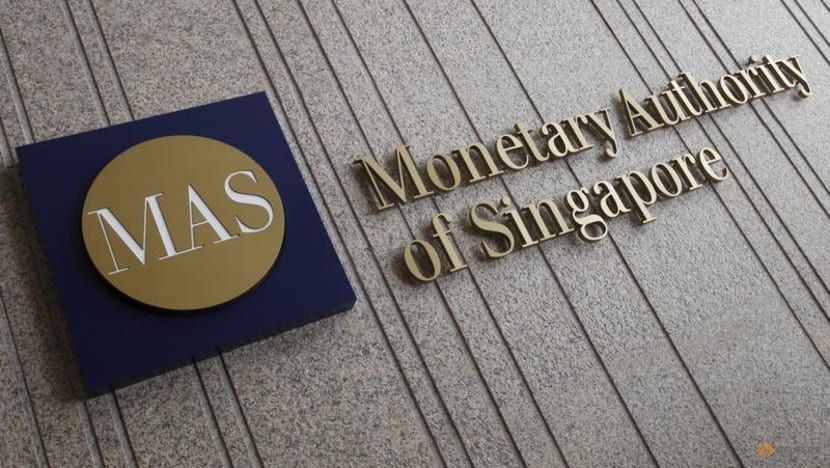MAS keeps monetary policy unchanged for fourth time in a row
While MAS will maintain its monetary policy, it will remain vigilant to risks to inflation and growth, the central bank says.


This audio is generated by an AI tool.
SINGAPORE: The Monetary Authority of Singapore (MAS) kept its exchange rate-based monetary policy unchanged on Friday (Apr 12), in line with analysts' expectations.
This is the fourth time in a row that the central bank has held policy steady.
In its April monetary policy statement, MAS said it would maintain the prevailing rate of appreciation of the Singapore dollar nominal effective exchange rate (S$NEER) policy band, and no changes would be made to its width and the level at which it is centred.
"MAS will closely monitor global and domestic economic developments, and remain vigilant to risks to inflation and growth," the statement said.
All 11 analysts polled by Reuters expected MAS to keep monetary policy unchanged at this meeting.
Instead of using interest rates like other central banks, MAS manages monetary policy by letting the Singapore dollar strengthen or weaken against the currencies of the country's main trading partners within the undisclosed S$NEER band.
To adjust policy, it changes the slope, mid-point and width of the band.
MAS has left monetary policy unchanged since October 2022, when the central bank re-centred the mid-point of its band.
OUTLOOK FOR ECONOMY, INFLATION
MAS said that prospects for Singapore's economy should improve over the year, noting that GDP growth is expected to be between 1 per cent and 3 per cent.
"The recovery in the manufacturing and financial sectors should resume, supported by the upturn in the electronics cycle and anticipated easing in global interest rates," the central bank said.
Growth in domestic-oriented sectors is also projected to normalise towards pre-pandemic rates.
The Ministry of Trade on Industry on Friday released advance GDP estimates for the first quarter of 2024 showing faster growth in consumer-facing sectors, which were partly supported by an increase in tourist arrivals.
Singapore's economy grew 2.7 per cent year-on-year in the first quarter of 2024, according to the estimates.
Global economic growth remained resilient at the beginning of the year, and is expected to be tempered in the near term among Singapore's major trading partners because of the effect of past monetary policy tightening and the withdrawal of expansionary fiscal policies.
Final demand should pick up in the later part of the year in line with the anticipated easing of global monetary policy, and global manufacturing should continue to recover, MAS said.
"This outlook is subject to uncertainties, including around the pace and timing of monetary policy easing and the intensity of ongoing geopolitical conflicts," the central bank added.
In terms of inflation, MAS said it expects core inflation to stay elevated in the near term before easing "more discernibly" in the fourth quarter of 2024 and into 2025.
Core inflation excludes the costs of accommodation and private transport.
MAS noted that water prices rose in April, adding that the prices of services such as education and healthcare will continue to catch up to higher costs.
Inflation edged up in January and February because of the step-up in the Goods and Services Tax (GST) rate, carbon tax hike and increases in essential services fees, MAS said.
But inflation in some segments of the economy – such as non-cooked food and food services – declined in the first two months of the year.
"Excluding the impact of the GST increases, underlying inflation is estimated to have been unchanged in Jan-Feb from Q4 last year," the central bank said.
Underlying inflation should moderate further as imported and domestic cost pressures continue to abate, it added.
Core and headline inflation are projected to come in at an average of between 2.5 per cent to 3.5 per cent for this year. Excluding the impact of the increase in the GST rate, both price indicators are forecast to come in at 1.5 per cent to 2.5 per cent.
Potential risks to the inflation outlook include shocks to global food and energy prices and stronger-than-expected demand for labour in the domestic economy. However, an unexpected weakening in the global economy could also cause prices to ease more quickly.
Current monetary policy settings remain appropriate given the expected strength and more broad-based growth of Singapore's economy, as well as the broadly moderating path of inflation, said MAS.
"The prevailing rate of appreciation of the policy band is needed to keep a restraining effect on imported inflation as well as domestic cost pressures, and is sufficient to ensure medium-term price stability," said the central bank.
Ms Selena Ling, OCBC's chief economist and head of global markets research and strategy, noted that many major central banks are hesitating when it comes to policy easing because recent inflation data has been bumpy and more buoyant.
"The monetary policy easing window is open (for the second half of the year), but is data-dependent," she said.
MAS could loosen policy in July or October if core inflation shows signs of subsiding earlier or more materially, but that is not OCBC's base case, said Ms Ling.
"April would have been too premature to pull the easing trigger given that the MAS view that core inflation will only step down from (the fourth quarter of 2024) into 2025 remains intact."

















